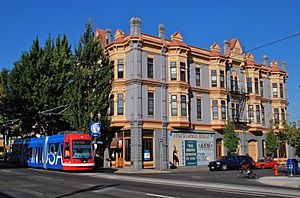East Portland, Oregon facts for kids

East Portland was once a separate city in Oregon. It joined with the city of Portland in 1891. Today, when people say "East Portland," they usually mean the part of Portland that is east of 82nd Avenue. Much of this area became part of Portland in the 1980s and 1990s.
East Portland: A City in the Past
The city of East Portland started on a large piece of land, about 640 acres. This land was claimed by a person named James B. Stephens in 1846. He bought it from John McLoughlin of the Hudson's Bay Company. East Portland officially became a city in 1871.
Stephens planned out the streets for the new city. This land stretched from the Willamette River to East First Street. It went from what is now Glisan Street to Hawthorne Boulevard. Much of this land was wet and swampy, with many small streams. This made it harder and more costly to build there compared to the land on the west side of the Willamette River. Many streets even had to be built on wooden bridges called trestles.
A few years later, another person named Gideon Tibbetts claimed 640 acres of land south of what is now Division Street. This area is now part of southeast Portland. Tibbetts built the first flour mill on the east side of the Willamette River. He also grew many fruit trees and hay on his land. He planned out some of his land in the Brooklyn neighborhood. He also added more land to East Portland. Later, Tibbetts sold some of his land and his flour mill to Stephens.
The land along the river in East Portland became very valuable in 1869. This was when the East-Side Oregon Central Railroad was finished. This railroad connected East Portland to Salem. A powerful railroad owner named Ben Holladay started a ferry service across the Willamette River to Portland. This ferry took people from the end of the railroad. Later, in 1880, a new ferry called the Oregon & California Railroad Ferry No. 2 took its place. Eventually, bridges like the Steel and Morrison bridges were built, making travel even easier.
On July 6, 1891, the cities of East Portland, Albina, and Portland all joined together. They became one big city called Portland, Oregon. At that time, East Portland had about 11,457 people. Around the same year, an area called Ladd's Addition was turned into a neighborhood with homes. This area was located between the land claims of Stephens and Tibbetts.
East Portland: A Modern Area
Today, the name "East Portland" often refers to the part of the city that is east of 82nd Avenue. About 28% of Portland's population lives in this area. Many people from different backgrounds, including Black and other minority groups, have moved to East Portland. This trend was expected to continue after 2011.
In March 2015, a group called East Portland de-Annexation Secession tried to separate from Portland. They wanted East Portland to become its own city again. However, their request was not approved because it did not meet the rules. A resident of East Portland, Collene Swenson, said she would try again with the help of lawyers.

